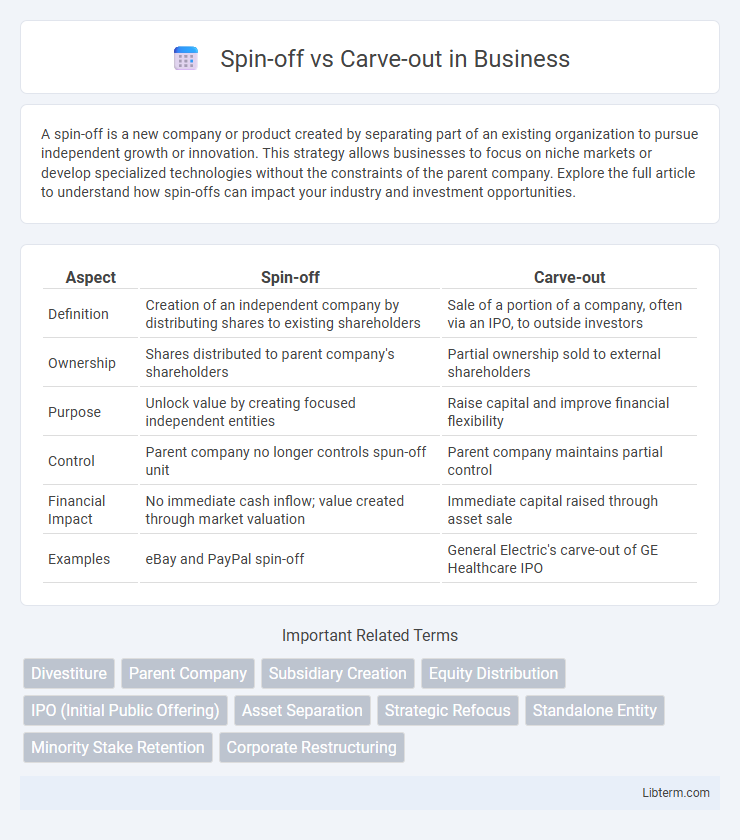A spin-off is a new company or product created by separating part of an existing organization to pursue independent growth or innovation. This strategy allows businesses to focus on niche markets or develop specialized technologies without the constraints of the parent company. Explore the full article to understand how spin-offs can impact your industry and investment opportunities.
Table of Comparison
| Aspect | Spin-off | Carve-out |
|---|---|---|
| Definition | Creation of an independent company by distributing shares to existing shareholders | Sale of a portion of a company, often via an IPO, to outside investors |
| Ownership | Shares distributed to parent company's shareholders | Partial ownership sold to external shareholders |
| Purpose | Unlock value by creating focused independent entities | Raise capital and improve financial flexibility |
| Control | Parent company no longer controls spun-off unit | Parent company maintains partial control |
| Financial Impact | No immediate cash inflow; value created through market valuation | Immediate capital raised through asset sale |
| Examples | eBay and PayPal spin-off | General Electric's carve-out of GE Healthcare IPO |
Introduction to Spin-off and Carve-out
Spin-offs involve a parent company creating an independent company by distributing new shares to existing shareholders, enabling focused growth and unlocking shareholder value. Carve-outs occur when a parent company sells a minority interest of a subsidiary to external investors through an initial public offering (IPO) or private placement while retaining control. Both strategies serve as corporate restructuring tools but differ in ownership retention and market exposure.
Defining Spin-off: Key Characteristics
A spin-off is a corporate restructuring strategy where a parent company creates an independent company by distributing new shares of a subsidiary to existing shareholders, allowing both entities to operate autonomously. Key characteristics include preserving shareholder value, enabling focused management teams, and unlocking hidden asset potential without external investment. Spin-offs typically result in separate trading of shares on stock exchanges, enhancing market valuation and strategic clarity.
What is a Carve-out? Core Features
A carve-out is a corporate divestiture where a company sells a portion of its business or a specific asset, creating a separate legal entity while retaining some ownership stake. Core features include the separation of financials, operations, and management for the carved-out unit, enabling targeted investment or strategic focus. Carve-outs often involve complex transactions such as partial equity sales, ensuring the parent company maintains influence while unlocking value from non-core assets.
Strategic Objectives of Spin-offs and Carve-outs
Spin-offs and carve-outs serve distinct strategic objectives within corporate restructuring aimed at value creation. Spin-offs focus on enhancing shareholder value by creating independent entities with clear strategic direction, enabling focused management and unlocking operational efficiencies. Carve-outs aim to generate capital through partial divestiture while maintaining strategic control, allowing companies to refocus on core operations and invest in high-growth areas.
Financial Implications: Spin-off vs Carve-out
Spin-offs involve distributing shares of a subsidiary to existing shareholders, often resulting in a tax-efficient separation and improved valuation transparency without immediate cash inflow. Carve-outs sell a minority stake in a subsidiary to external investors, generating immediate capital but potentially diluting control and creating ongoing parent-subsidiary relationships. Financial implications of spin-offs typically include reduced debt on the parent's balance sheet, while carve-outs impact liquidity and shareholder structure more directly due to partial divestiture.
Impact on Shareholders and Stakeholders
A spin-off creates a new independent company by distributing shares to existing shareholders, often enhancing shareholder value through targeted management and focused business strategies. Carve-outs involve selling a portion of a company to outside investors while retaining control, potentially diluting existing shareholders' stakes but attracting new capital and partnerships. Both restructurings affect stakeholders by reshaping corporate governance, operational focus, and investment risks, with spin-offs typically delivering greater autonomy to the new entity and carve-outs fostering strategic collaboration.
Legal and Regulatory Considerations
Spin-offs require compliance with Securities and Exchange Commission (SEC) regulations, including filing Form 10 or Form 10-12B, while ensuring tax-free treatment under Internal Revenue Code Section 355. Carve-outs involve registering new securities with the SEC and securing approvals from relevant regulatory bodies, often facing stricter disclosure and reporting obligations. Both transactions necessitate careful adherence to antitrust laws, intellectual property rights, and employee transfer regulations to mitigate legal risks.
Operational Challenges and Risks
Spin-offs often face operational challenges related to establishing independent corporate functions, such as IT systems, supply chains, and human resources, leading to significant transition risks. Carve-outs pose risks in disentangling integrated operations, including complex financial separation and potential disruption to ongoing business processes. Both transactions demand meticulous planning to mitigate risks like loss of economies of scale, data security vulnerabilities, and employee retention issues that can impact post-transaction operational efficiency.
Notable Examples: Spin-off and Carve-out Cases
Spin-off examples include PayPal's separation from eBay in 2015 and Hewlett-Packard's split into HP Inc. and Hewlett Packard Enterprise in 2015, enabling focused business strategies and unlocking shareholder value. Carve-out cases involve partial divestitures with retained ownership, such as General Electric's sale of GE Lighting to Savant Systems in 2020 and Kraft Heinz spinning off its Planters snack business in 2021, raising capital while maintaining strategic control. These corporate restructuring methods demonstrate distinct approaches to optimizing portfolios and enhancing market positioning.
Choosing the Right Strategy: Spin-off or Carve-out?
Choosing the right strategy between a spin-off and carve-out depends on the company's goals for operational independence and capital structure. Spin-offs create a completely independent entity by distributing shares to existing shareholders, ideal for unlocking shareholder value and focusing on core businesses without external interference. Carve-outs involve selling a minority stake through an IPO, enabling the parent company to retain control while raising capital and increasing market visibility.
Spin-off Infographic

 libterm.com
libterm.com